Saint Helena: Live it – Experience it – Enjoy it
After two weeks in Namibia, Canadian cruisers Brent Crack and Mary Bevan (who are nearing the end of their circumnavigation) set sail for the tiny island of Saint Helena in the south Atlantic Ocean, where they experienced one of the real highlights of their sailing adventure to date.
Published 2 months ago, updated 1 month ago
A Pea Soup Farewell from Namibia
After two weeks spent in Walvis Bay, Namibia, it was time to depart for our next port – the island of Saint Helena in the south Atlantic Ocean. We chose to leave on New Year’s Eve as we wanted to go before the 2000 partiers and live bands started to ring in the new year. Exactly one year before, we had been at anchor in front of the Sydney Opera house, fending off other boats to celebrate the new year and we wanted this year to be a calm one.
We departed in a pea soup fog type of morning. Cold and damp because of the 14degC water temperature, we cautiously worked our way out of the harbour, gliding quietly past the numerous freighters and fishing boats. Once we rounded Pelican Point, the course was set north west to Saint Helena, approximately 1250 nautical miles distance.
As the sun rose and the day broke, the fog slowly dissipated and the winds picked up. Repeatedly checking the water temperature showed a steady increase as we travelled our course, a sign we were crossing out of the Benguela current, which was bringing cold water north from the Antarctic. Hitting 20degC by the end of the first day was a big milestone as it was the warmest the water had been in some time. It was great to feel warm again and no longer need hats and jackets.
Perfect Sailing Conditions
Over the first three days, the winds slowly switched to dead behind us at 12-17 knots — perfect parasail conditions which we took advantage of. The parasail is our absolute favourite sail, giving the fastest boat speeds with the most comfort on board. We continued to use this sail for the entire remaining duration of the trip to Saint Helena.
Saint Helena requests notification via radio 30nm from arrival. We sort of rolled our eyes at this request, not expecting any answer because of the distance. We dutifully made the call at the 30nm limit in the wee hours of the morning and were quite surprised to have an extremely loud and clear response. The island has some impressive long range radio capabilities! We were told to proceed to Jamestown and report again when five miles and one mile out.
At the one mile report, we were asked to call the harbour master on Channel 14 to arrange anchorage spots. As the mooring field is now gone (a yacht broke free and sunk on shore, requiring a payout by the community), the harbour master now allocates specific GPS way points for anchoring. Each vessel is to call to receive their “spot” to ensure spacing of the vessels and that the anchor location is an area known to be free. Note: One vessel anchored at the extreme northern end of the anchorage area ended up with a stuck anchor. Divers called out found it hooked on a massive, ancient ships anchor. All was cleared but that area will most likely no longer be an anchorage position.
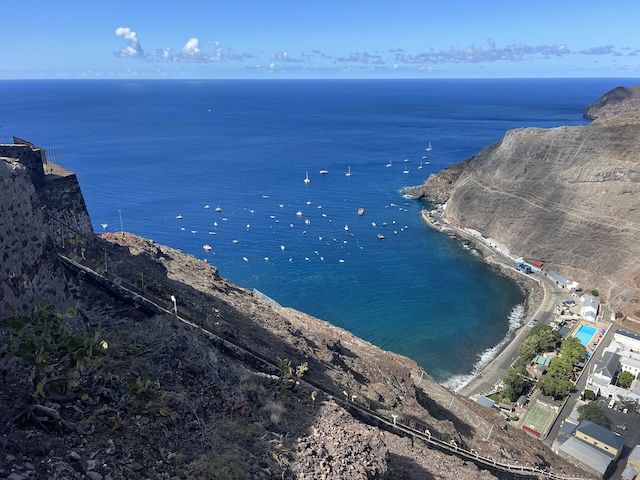

Local Advice – Use the Ferry Service
We were advised that once anchored we could take our dinghy to shore or call the ferry service for delivery, but that there is a fee for the ferry. Judging by the swell pounding in at the dock, we opted to go for the ferry instead of trying to tie our dinghy in the large waves and currents.
There is a new operator of the ferry and we were quickly advised that pricing is now £2.50/person for each return trip. The ferry will run a tab and collect before departure. The ferry operates every day, unless cancelled because of swell conditions. Always check when the last ferry will be, but normal times are 0800 to 1845. Outside of those times it is a minimum rate of £25 and minimum of £5 per person, making a boat of 6 people cost £30. The ferry can be called on channel 16 “Ferry Service”.
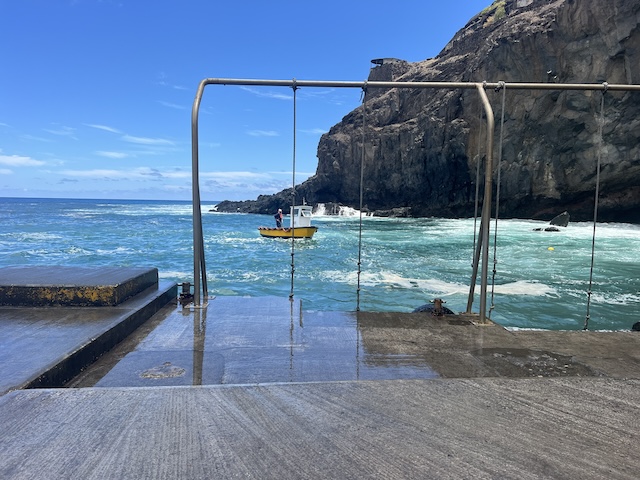

A warm welcome from the government officials soon awaited. All the required folks are located in the white, two story building with the clock on your left side as you walk up the road from the dock. Fees apply if you are staying more than three days. £20/person for immigration charges. £35 for harbour dues. Immigration is to be paid on arrival. Harbour dues are paid prior to check out.
Cash is King
This now is a good time to bring up the Saint Helena Bank card. Businesses in Saint Helena do not commonly accept credit cards. It is primarily a cash based society, but there are no bank machines for getting cash. There is only one bank in which one has to stand in line and then get a cash advance on their credit card (bring passport). To help make it easier for travellers, a Saint Helena bank card is a system whereby travellers to Saint Helena can pre load an app with funds and then display the QR code for scanning at time of purchase to deduct from the preloaded funds. Sounds good in theory, but in practice it is simply not functional.
The biggest issue — many places do not take the Saint Helena Card and will only accept cash. So no matter what you do, you will have to get cash out. A prime example of this is with the government agencies at check in. Immigration accepts the Saint Helena card app. Harbour master wants cash only. Will not use the card. Ferry dues, cash only. Yacht Club, cash only. No matter how much one tries to use just the card, local cash will be needed. The card can be used at the bank to withdraw cash. The card does not display how much funds are left on it and it is not easy to look up so one has to keep detailed records as going about their travels as to how much is remaining. All in all, we found relying on the Saint Helena card app to be a complete waste of everyone’s time. Our suggestion: Arrive at the island with enough British pounds to pay any immigration fees. Then go straight to the bank and get enough cash on a visa advance to spend during your time.
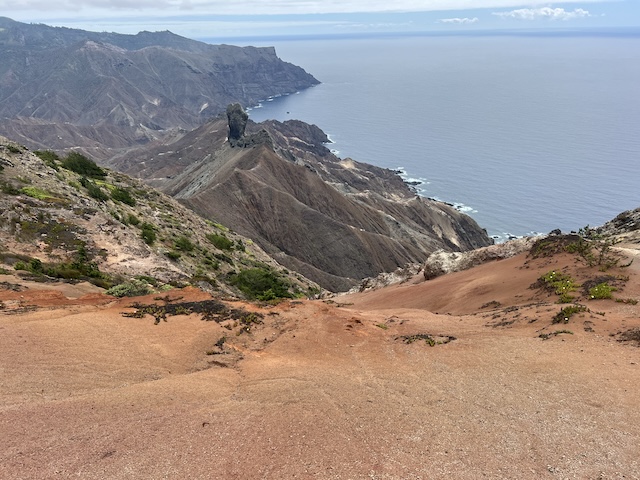

We had originally planned to spend just three days in Saint Helena, but soon came to realize it is a special place and the calendar went out the window. We ended up spending a week and still felt like we could have easily spent another.
Friendly and Hospitable Locals
The friendliness of the locals was the first take way. Get your waving hand exercised as everyone will wave at you and all will say hello. It took us back to some of the remote atolls in the South Pacific, when walking down the street was an exercise in greeting every single person you saw.
Quite honestly, it was a welcome change from many of the less hospitable parts of the world. Businesses do not have any idea who you are, but will quickly extend credit until one can get to the bank to get cash. The entire circumstance felt like a society based on trust and respect and that is certainly something we enjoyed.
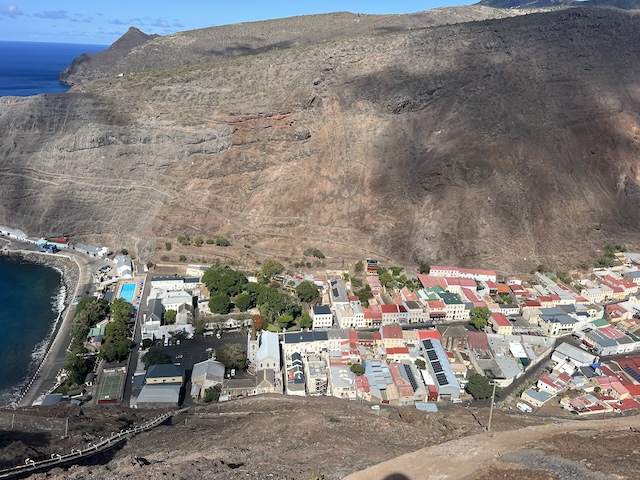

More than Napoleon
Napoleon is a big deal on the island, but there is so much more to the island than just Napoleon. If one focuses just on the little emperor and does not do anything else, they will completely miss out on what it means to visit Saint Helena. Napoleon was exiled on Saint Helena for approximately five years and died during his exile. The Tomb of the Emperor is a scenic walk and the visit to Longhouse (Napoleons home) is interesting and filled with the minutia of his life on the island.
There is so much more to Saint Helena. Take any of the fantastic hikes available on the island. Great scenery, good trails and friendly locals are everywhere. They are quick to ask where you are going and ensure you get set up on the right path. One of our favourite hikes was the Blue Point Lookout Trail which was fairly easy with some great views of the islands. Other cruisers went on a hike called Flagstaff and raved about it. Take a drive down to Sandy Bay and check out the old fort but make sure to stop at Wingham’s coffee on the way down. They are growing a variety of coffee on the island that is well received in the global community and offer tours through the tourism office. A visit with the proprietors is always a special experience with a great opportunity to learn about the coffee history of the island.
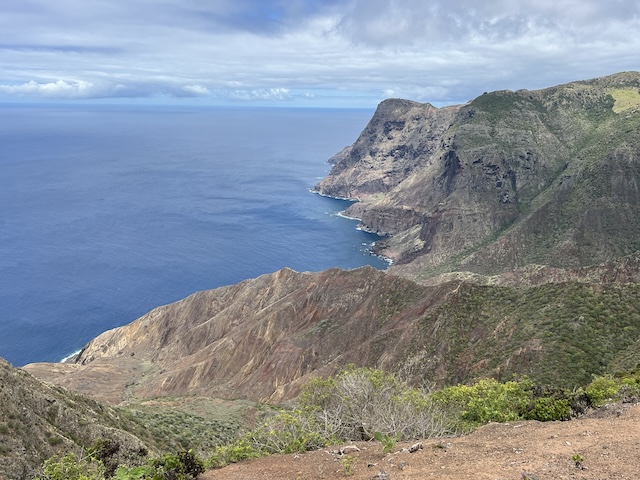

A note on provisioning. Buy everything you want and need before coming to the island. It is remote and the price of goods can be expensive and often double or more from your last port of call. Price aside, the availability of items can be very limited. When we were there, the supply ship had already been delayed in excess of a week and was anticipated to be at least two weeks further delayed. As such, many items were in short supply and eggs could not be found in grocery stores. Fresh produce was limited and it became a daily scavenger hunt to run around to each shop first thing in the morning to see what had been delivered in by the few farmers that morning. Be early or that produce will be gone! Check in stores that don’t look like they would ever sell produce and you will be surprised at what you can find. Some restaurants will also sell extra produce, so don’t be afraid to ask anyone and everyone where things can be found.
Store hours can be a bit like many of the Polynesian atolls — on the whim of the owners and employees with not much set out. It can be tough to figure out what is open and when, but the main stores seem to be 9-4 Monday to Friday with many closing at noon on Wednesdays. Some are open on Saturdays until noon, but not all. Most everything is closed on Sundays, including restaurants. We were advised by other cruisers who visited the island through the Christmas holiday period that absolutely no stores were open during this time and they could not purchase or do anything, so be aware of that potential if you visit during the holidays.
All in all, Saint Helena was a fantastic stop on our sailing trip so far. It is one of the highlights and we would strongly recommend others give it some time to enjoy the island and people. Don’t plan on stopping for just a couple of days. Live it. Experience it. Enjoy it.
Brent Crack and Mary Bevan
SV Knot Safety
……………………………
About the Authors:
Brent Crack and Mary Bevan are two Canadian citizens who are sailing around the world on their Lagoon 400 catamaran SV Knot Safety. After leaving Panama in December 2022, they are following a path to “go where others don’t” in their circumnavigation and have crossed the Pacific via Easter Island, French Polynesia and the Cook Islands to New Zealand. After crossing the Tasman Sea to Sydney, Australia, they took the southern route of Australia to Fremantle and Geraldton in Western Australia which was their departure point for their Indian Ocean Crossing. They arrived in South Africa after a long ocean crossing and discovered a memorable and impactful country. There next voyage is across the Atlantic from Namibia to Brazil, stopping at the tiny south Atlantic Ocean island of Saint Helena on the way.
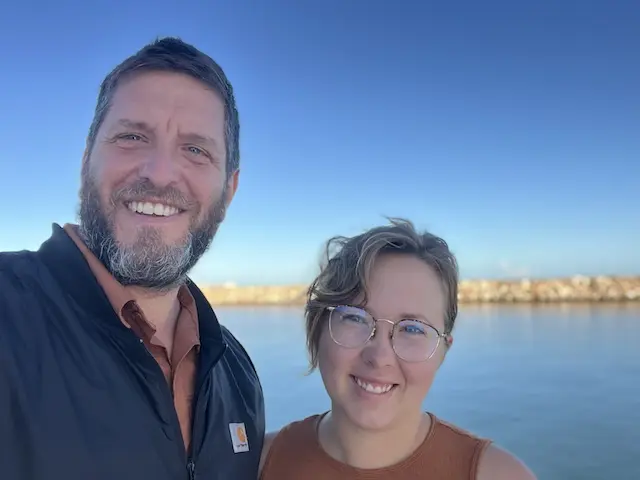
Other reports from Brent and Mary’s Circumnavigation Odyssey:
- Namibia: From Sea Fog to Magical Landscapes
- South Africa: An Enjoyable and Impactful Country
- Indian Ocean Crossing Part 2: Rodrigues – Reunion – Richard’s Bay
- Indian Ocean Crossing Part 1: Australia to Rodrigues
- Australia: Dodging Lobster Pots and Aquaculture Pens across the Great Australian Bight
- Australia: Heading South From Sydney Going West
- Australia, Sydney: New Year’s Eve Magic and Chaos.
- Cook Islands, Rarotonga: We’d Return in a Heartbeat – Just Not With a Boat!
- French Polynesia: Making Sense of Anchoring Restrictions
- French Polynesia, Society Islands: The Beauty and Disappointment
- French Polynesia, Tuamotus: Coral Bombies, Snorkelling and Sharks
- French Polynesia – A Warm Welcome to the Gambiers
- Pitcairn Island – Well Worth the Journey
- Rapa Nui (Easter Island) – Nothing Short of Amazing
………………………………
© 2025 Noonsite. This content was edited by Noonsite. Do not reproduce without permission. All rights reserved.
The opinions expressed in this article are the author’s own and do not reflect the view of Noonsite.com or World Cruising Club.
Find out all news, reports, links and comments posted on Noonsite, plus cruising information from around the world, by subscribing to our FREE monthly newsletter. Go to https://www.noonsite.com/newsletter/.
Related to following destinations: Cape Town (Table Bay), Jamestown, Namibia, South Africa, St. Helena, Walvis Bay
Related to the following Cruising Resources: Atlantic Ocean South, Circumnavigation, Circumnavigation, Routing


